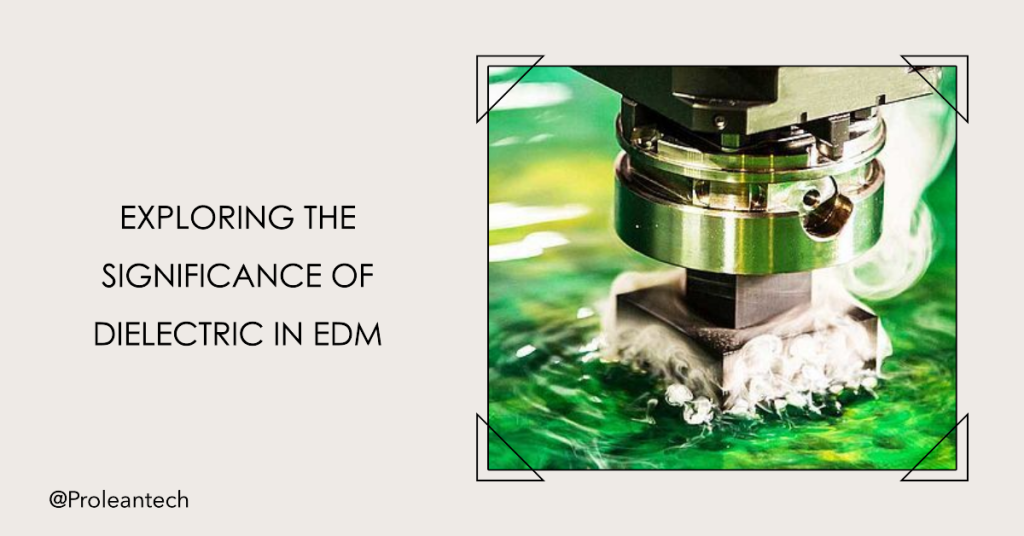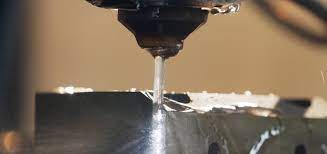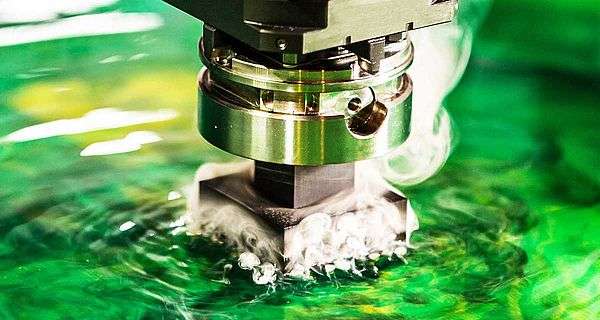 Electrical Discharge Machining (EDM) is a highly precise and efficient machining method widely used in various industries. It involves the controlled erosion of electrically conductive materials through a series of carefully controlled electrical discharges. One crucial element in the EDM process is the dielectric, a specialized fluid that plays a vital role in facilitating material removal and ensuring the accuracy of the machining operation.
Electrical Discharge Machining (EDM) is a highly precise and efficient machining method widely used in various industries. It involves the controlled erosion of electrically conductive materials through a series of carefully controlled electrical discharges. One crucial element in the EDM process is the dielectric, a specialized fluid that plays a vital role in facilitating material removal and ensuring the accuracy of the machining operation.

Dielectric fluid for wire EDM
Understanding the role of the dielectric in EDM is crucial for achieving optimal results. The dielectric serves to insulate, cool, flush, and control spark erosion. By exploring the significance of the dielectric, we can gain valuable insights into how it impacts machining performance, surface finish, and efficiency.
In this article, We will explore the importance of dielectric in EDM, including fluid types, performance factors, technology advances, environmental concerns, and disposal methods.
Functions of the Dielectric in EDM

Dielectric fluid-sinker EDM
The dielectric plays a crucial role in the Electrical Discharge Machining (EDM) process. It serves various functions that contribute to the overall efficiency and effectiveness of the machining operation.
Let’s explore the key functions of the dielectric in EDM in detail:
Electrical Insulation
The dielectric fluid serves as an electrical insulator, establishing and maintaining the gap between the electrode and the workpiece, allowing the controlled flow of electrical current during the discharge. By insulating the workpiece and electrode, the dielectric ensures that the electric discharge occurs only at the desired location, facilitating precise material removal.
Cooling and Flushing
The dielectric fluid is a coolant, dissipating the heat generated during the EDM process. It absorbs and carries away the thermal energy from the machining zone, preventing excessive heat accumulation that can damage the workpiece or electrode. The dielectric’s continuous circulation helps maintain a stable temperature, ensuring consistent machining performance and minimizing the risk of thermal distortion.
Control of Spark Erosion
Spark erosion is a fundamental phenomenon in EDM where controlled electrical discharges remove material from the workpiece. The dielectric fluid acts as a medium for the electrical discharges, providing an ionized path for the spark to travel through.
It controls the spark erosion process by regulating the electrical discharges’ intensity, duration, and frequency. By controlling the spark erosion, the dielectric ensures precise material removal, maintains surface integrity, and contributes to achieving the desired surface finish.
Flushing and Debris Removal
The dielectric fluid acts as a flushing medium, carrying away the eroded particles, debris, and dissolved material from the machining zone. It helps to prevent the accumulation of debris, which can interfere with the machining process and compromise the accuracy of the operation.
The continuous flow of the dielectric flushes out the debris, ensuring a clear and unobstructed path for the electrical discharges.
Dielectric Gap Control
The dielectric controls the gap between the electrode and the workpiece during the machining process. It helps maintain a consistent and optimal gap distance, ensuring stable electrical discharge and minimizing the risk of arcing or short circuits. The dielectric’s ability to control the gap distance contributes to the EDM operation’s accuracy, precision, and repeatability.
Prevention of Oxidation and Corrosion
Certain dielectric fluids, such as oil-based dielectrics, provide a protective layer that prevents oxidation and corrosion of the workpiece surface during the machining process. This protective layer helps preserve the integrity of the workpiece material, particularly when working with materials prone to oxidation or corrosion.
Types of Dielectric Fluids Used in EDM
Dielectric fluids play a vital role in the Electrical Discharge Machining (EDM) process, providing electrical insulation, cooling, debris removal, and other essential functions. Various dielectric fluids are available, each with its characteristics and suitability for different applications.
The following are some of the commonly used dielectric fluids in EDM:
Hydrocarbon-Based Dielectric Fluids
Hydrocarbon-based dielectric fluids, such as mineral or petroleum-based oils, are widely used in EDM applications. They offer good electrical insulation properties and provide adequate cooling and flushing capabilities. Hydrocarbon-based fluids are suitable for general-purpose EDM operations and can work well with various workpiece materials. These fluids are cost-effective and readily available, making them popular in many EDM applications.
Synthetic Dielectric Fluids
Synthetic dielectric fluids are formulated using synthetic hydrocarbons or chemical compounds. They offer improved performance compared to hydrocarbon-based fluids, including better dielectric strength, higher flash point, and enhanced thermal stability. Synthetic fluids provide excellent cooling properties and help to minimize electrode wear during the EDM process. They are often preferred for high-precision machining applications or when working with complex geometries.
Deionized Water
Deionized water is a common dielectric fluid used in EDM, particularly for applications requiring fine surface finishes or when working with heat-sensitive materials. Water-based dielectric fluids offer good thermal conductivity and can effectively remove debris from the machining zone. Deionized water is non-flammable and environmentally friendly, making it a sustainable option for certain EDM operations. However, precautions must be taken to prevent corrosion and ensure proper filtration to remove impurities from the water.
Low Viscosity Dielectric Fluids
Low-viscosity dielectric fluids are designed to have a lower viscosity than traditional dielectric fluids. These fluids offer improved flushing capabilities and can effectively remove debris and eroded particles from the machining zone. Low-viscosity fluids help to maintain a clear and unobstructed path for electrical discharges, improving machining efficiency and accuracy. They are particularly beneficial when machining intricate or fine features, as they can effectively reach narrow gaps and channels.
Dielectric Fluid Additives
Dielectric fluid additives can be combined with base fluids to enhance their performance and characteristics. Additives such as rust inhibitors, anti-wear agents, and surfactants can improve the dielectric fluid’s lubricity, stability, and debris removal capabilities. These additives can be customized based on specific application requirements and workpiece materials.
Table: Comparison of Dielectric Fluid Types
| Dielectric Fluid Type | Properties and Benefits | Applications |
|---|---|---|
| Hydrocarbon-based | Cost-effective, good cooling and insulation | General-purpose EDM |
| Synthetic | Improved dielectric strength, thermal stability | High-precision machining |
| Deionized water | Non-flammable, environmentally friendly | Fine surface finishes |
| Low viscosity | Enhanced flushing, debris removal | Intricate or fine features |
| Additives | Improved lubricity, stability, debris removal | Customizable applications |
Try Prolean Now!
Factors Affecting Dielectric Performance
Various factors can influence the performance of dielectric fluids in Electrical Discharge Machining (EDM). Understanding these factors is crucial for optimizing the EDM process and achieving desired machining results. Let’s delve into the key factors that can affect dielectric performance:
1 Dielectric Fluid Properties
| Dielectric Fluid Property | Description |
|---|---|
| Dielectric constant | Determines ability to insulate and resist electrical discharge. Higher dielectric constants provide better insulation and enhance EDM efficiency. |
| Viscosity | Affects flow and flushing capabilities. Low-viscosity fluids can effectively remove debris and eroded particles, while high-viscosity fluids may hinder flushing and result in a poor surface finish. |
| Flash point | Indicates the temperature at which fluid can ignite when exposed to an open flame or spark. Lower flash point fluids can pose safety risks, while higher flash point fluids offer greater stability during the EDM process. |
| Oxidation stability | Fluids should possess good oxidation stability to withstand prolonged exposure to electrical discharges and high temperatures. Stable fluids resist degradation and maintain their properties, ensuring consistent performance over time. |
2 Contamination and Filtration
Contaminants such as metal fines, debris, and eroded particles can accumulate in the dielectric fluid, affecting its performance. Contamination can lead to poor flushing, reduced dielectric strength, increased electrode wear, and compromised surface finish. Furthermore, effective filtration systems are essential to remove contaminants from the dielectric fluid. Filtration helps maintain the fluid’s cleanliness, prolong its useful life, and improve the overall EDM process. Regular filtration and maintenance practices are crucial for optimal dielectric performance.
3 Temperature Control
The temperature of the dielectric fluid has a significant impact on EDM performance. Excessive heat can degrade the fluid, reduce its dielectric strength, and negatively affect the machining process.
Therefore, a proper cooling system, such as chillers or heat exchangers, is required to maintain the dielectric fluid at an optimal temperature. Cooling prevents excessive temperature rise during the EDM process, ensuring consistent performance and prolonging fluid life.
4 Dielectric Fluid Circulation & Maintenance
| Systems & Practices | Description |
|---|---|
| Adequate fluid circulation | Vital for effective debris removal and maintaining properties |
| Pumping systems | Well-designed systems with appropriate flow rates ensure sufficient fluid circulation throughout the machining zone. Proper nozzle placement and flushing strategies help remove debris and maintain fluid integrity |
| Regular maintenance practices | Critical for preserving dielectric fluid performance. Key activities include monitoring fluid levels, conducting regular analysis and testing, implementing proper filtration systems and cleaning procedures, and periodically replacing the fluid to maintain optimal performance |
By considering these factors and implementing appropriate measures, EDM operators can optimize dielectric performance, enhance machining efficiency, and achieve desired results.
5 Table: Key Factors Affecting Dielectric Performance
| Factor | Description |
|---|---|
| Dielectric fluid properties | The dielectric constant, viscosity, flash point, oxidation stability |
| Contamination and filtration | Presence of contaminants, the effectiveness of filtration systems |
| Temperature control | Cooling systems, maintaining an optimal temperature |
| Dielectric fluid circulation | Pumping systems, nozzle placement, flushing strategies |
Advances in Dielectric Technology
Dielectric fluids are crucial in the Electrical Discharge Machining (EDM) process, providing electrical insulation, cooling, and debris removal. Over the years, advancements in dielectric technology have led to the development of innovative fluids that offer improved performance and enhanced capabilities. Let’s explore some of the critical advances in dielectric technology.
| Advancements in Dielectric Technology | Properties and Benefits | Applications |
|---|---|---|
| High-Performance Dielectric Fluids | Higher dielectric strength, Enhanced cooling, Reduced electrode wear, Improved flushing ability | Increased material removal rates and improved surface finish |
| Environmentally Friendly Dielectric Fluids | Low toxicity and low environmental impact, Biodegradability, Reduced waste generation, Compliance with regulations | Sustainable option for certain EDM operations |
| Advanced Filtration Systems | Enhanced filtration capabilities, Extended fluid life, Improved machining performance, Optimal dielectric strength | Cleaner fluid for more extended periods, reducing fluid replacement frequency and costs |
| Real-Time Monitoring and Control Systems | Process optimization, Energy efficiency, Predictive maintenance, Data-driven insights | Optimal EDM performance |
| Advanced Additives and Formulations | Enhanced lubricity and cooling properties, Anti-wear and anti-corrosion properties, Extended tool life, Customizable formulations | Tailored to specific application requirements and workpiece materials |
CNC EDM Services at ProleanTech
At ProleanTech, we offer high-quality CNC EDM services, utilizing advanced equipment and technology to deliver precise and efficient machining solutions. Our team of experienced engineers and technicians is dedicated to providing exceptional results and meeting the unique needs of our clients across various industries.
With our state-of-the-art equipment and expertise in EDM processes, we can help you achieve optimal results, reduce lead times, and improve production efficiency. Contact us today to learn more about our CNC EDM services and how we can help you achieve your machining goals.
Read More:
- Electrical Discharge Machining: An Essential Beginner’s Guide
- CNC Fasteners Machining: A Comprehensive Step-by-Step Guide
- Comparing Electric Discharge Machining and Laser Cutting in Modern Manufacturing
Conclusion
In conclusion, understanding the role and importance of dielectric in EDM is crucial for achieving optimal results. Dielectric fluids offer various functions that contribute to the overall efficiency and effectiveness of the machining operation, including electrical insulation, cooling, flushing, control of spark erosion, debris removal, and prevention of oxidation and corrosion.
EDM operators can optimize dielectric performance, enhance machining efficiency, and achieve desired results by considering dielectric fluid properties, contamination and filtration, temperature control, dielectric fluid circulation & maintenance, and advances in dielectric technology.
FAQ’s
What are the different types of dielectric fluids used in EDM?
Different dielectric fluids, such as hydrocarbon-based, synthetic, deionized water, low viscosity, and fluid additives, are available. Each type has unique features and is suitable for various applications, depending on factors such as workpiece material and machining requirements.
How can dielectric performance be optimized in EDM?
Factors such as fluid properties, contamination, temperature control, fluid circulation, and technology should be considered to optimize dielectric performance. Operators can enhance machining efficiency and achieve desired results by using high-performance fluids, maintaining proper filtration and cooling systems, and monitoring and controlling the EDM process.
What are the advantages of EDM?
EDM has many benefits compared to traditional machining methods. It can machine complex geometries, work with hard and brittle materials, and achieve high precision and accuracy. The process is non-contact, reducing the risk of damage or distortion. EDM is widely used in aerospace, automotive, medical, electronics, and other industries.




0 Comments